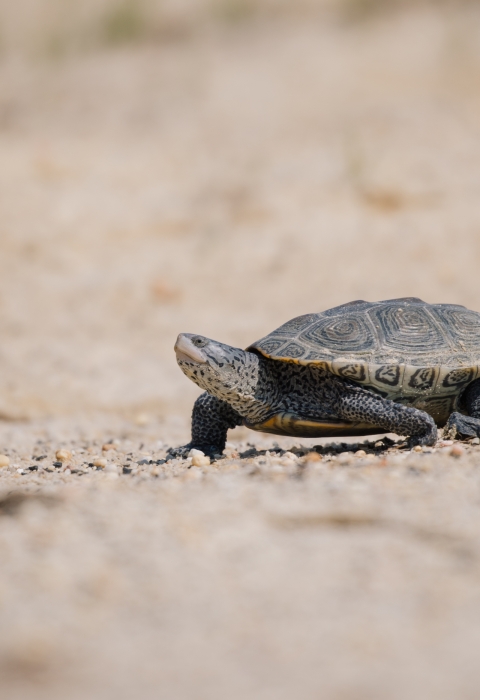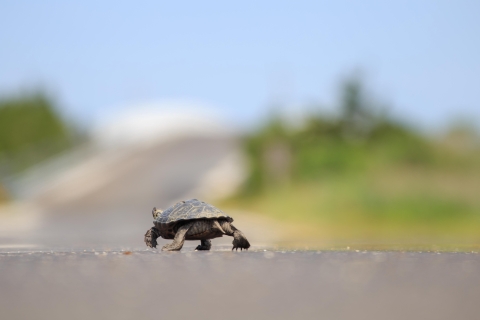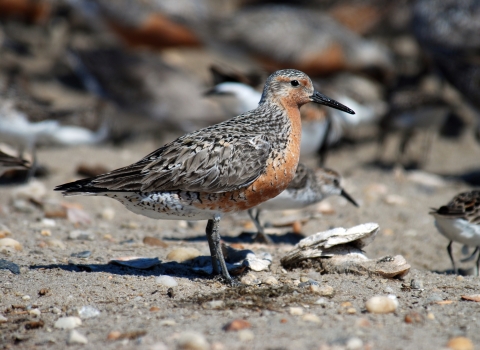Diamondback terrapins follow a regular seasonal pattern. In winter, they hibernate in the banks of creeks in coastal marshes. In early spring, they emerge from the mud to look for mates. In late spring and early summer, females lay eggs in sandy areas above the high tide line.
For 15 years, David Sommers followed a seasonal pattern too. Starting in May, he would make regular trips from his home in Levittown, Pennsylvania, to the New Jersey shore, with plastic tubs in the trunk of his car.After dark, he would drive along an isolated stretch of road that runs through a coastal state wildlife management area wildlife management area
For practical purposes, a wildlife management area is synonymous with a national wildlife refuge or a game preserve. There are nine wildlife management areas and one game preserve in the National Wildlife Refuge System.
Learn more about wildlife management area .
His seasonal pattern mirrored that of his targets: female diamondback terrapins, which he knew crossed that road every spring to reach the sandy uplands where they build their nests. He knew that they would be gravid, or carrying eggs. He took them from their home, back to his, and then he took their young.
“Sommers would inject them with oxytocin, the same drug used to induce labor in pregnant women, to get them to lay eggs, and then he would sell the females online,” explained Ryan Bessey, a special agent with the U.S. Fish and Wildlife Service’s Office of Law Enforcement. “A legitimate dealer wouldn’t be selling adult females during the breeding season — that’s their brood stock,” he said.
“That was one of the red flags.”
There were many others. Like the package Sommers attempted to mail to Canada that he labeled as “books,” but that actually contained 11 hatchling diamondback terrapins. The package turned into a Pandora’s box for Sommers: it contained violations of the Lacey Act (for false labeling), the Convention on International Trade in Endangered Species of Wild Fauna and Flora (for shipping a listed species abroad without a permit), and the Service’s standards for humane shipment of live animals (for enclosing turtles in fabric bags sealed with duct tape, inside a USPS flat-rate box punched with air holes, inside a USPS flat-rate envelope that concealed those holes).
With help from the New Jersey Division of Fish and Wildlife, Pennsylvania Fish and Boat Commission, U.S. Postal Inspection Service, and The Wetlands Institute, Bessey pieced together a case against Sommers over several years. Last October, he received a warrant to search the suspect’s Levittown home. He found 3,442 more red flags: 3,442 hatchling diamondback terrapins, produced from the eggs Sommers took from females, and from eggs he took directly from nests on subsequent trips to the shore. They were the stock for his online business selling “captive-bred” turtles.
Sommers pleaded guilty in February to trafficking protected turtles, and was sentenced today in the U.S. District Court for the Eastern District of Pennsylvania to six months’ imprisonment, three years’ supervised release including six months’ home detention, and $250,000 restitution based on records of sales going back to 2011.
Fortunately, his captives were set free months ago — a rare outcome in wildlife confiscations.
“In most cases, it’s not so cut and dry,” Bessey said. “It’s hard to release them when we don’t know where they came from, or what they have been exposed to.”
When turtles have been kept in captivity, in conditions that are unnatural — imagine lots of turtles sharing a small tank, or kept in close proximity to other species of turtles, or king cobras — it’s risky to just let them go in any suitable habitat. They can introduce diseases, or muddy the gene pool of populations that have adapted to survive in certain places over generations. Likewise, the rescued individuals are not likely to survive in foreign landscapes.
But because Sommers had a pattern, collecting from the same place year after year, there was no doubt about where the terrapins came from. The hatchlings had not been in captivity for long, and they were kept apart from other species (some eastern box turtles were found in an enclosure outside), which reduced the likelihood that they had been exposed to novel pathogens.
“My first inclination was to figure out: can we get these back into the wild?” Bessey said.
After getting the OK from federal prosecutors in Philadelphia and Washington, D.C., and from the New Jersey Division of Fish and Wildlife, Bessey loaded a trailer with terrapins.
Then he called in reinforcements.
The lost generation
Brian Williamson patrols roadways in the spring looking for diamondback terrapins too. He catches females, and he collects eggs. But his objective is to strengthen the population, not to exploit it.
“We have a permit from the state of New Jersey to collect the eggs, and we raise the hatchling turtles in captivity for 10 months, then release them back into the wild,” said Williamson, a research scientist with The Wetlands Institute, a nonprofit organization based in Stone Harbor, New Jersey.
The goal is to increase the chances that the hatchling terrapins, which are about the size of a quarter, will survive to adulthood and replace those that are killed on roadways each spring.
During his patrols, Williamson catches live females, which he measures and releases, but he also tallies the dead to get a sense of how many are lost. There’s no accounting for terrapins that are snatched in the night without a trace. Until recently, he wouldn’t have thought he needed to account for them.
“I was really surprised when I got a call from Special Agent Bessey saying he had thousands of turtles that needed to be released,” Williamson recalled.
For his part, Bessey was surprised when Williamson explained the protocol they needed to follow to release them. They couldn’t just let a trailer-load of tiny terrapins loose in the water. “That’d be like ringing a dinner bell for the gulls,” Williamson said.
Instead, each terrapin had to be tucked into its own little pocket of marsh grass, out of sight of predators. Multiply that by 3,442.
“We could see the lights of Atlantic City in the distance when we finished, that’s how dark it was,” Bessey said, blithely.
It was worth the effort. Although Williamson said there’s no telling how many of those hatchlings will survive long enough to reach adulthood, “Some of them may, and it was important to give them that chance.”
But it likely won’t be enough to make up for all of the adults Sommers removed from the population permanently over the years.
Turtles have evolved to compensate for low juvenile survival rate with long adult lifespans. Once turtles reach sexual maturity, they can reproduce every year for the rest of their lives, which for diamondback terrapins can be as long as 40 years. Other native turtle species can live decades longer. “These animals live so long that eventually, they might win the lottery,” Williamson said. For a turtle, “winning the lottery” means one of your hatchlings makes it to adulthood so you replace yourself in the population.
“Adult female terrapins — animals that somehow survived the eight years it takes to reach sexual maturity, and now have a pretty good chance of making it year after year because they are big enough that they don’t have many natural predators — those are the individuals we need reproducing,” Williamson said. “If those terrapins are taken from the wild, induced to lay eggs, and sold in the pet trade, that has the potential to cause real damage to populations.”
Populations which, he noted, already face heightened threats from climate change climate change
Climate change includes both global warming driven by human-induced emissions of greenhouse gases and the resulting large-scale shifts in weather patterns. Though there have been previous periods of climatic change, since the mid-20th century humans have had an unprecedented impact on Earth's climate system and caused change on a global scale.
Learn more about climate change , habitat loss, cars, and discarded crab pots, which terrapins frequently become trapped in and drown.
“Poaching is just one of the problems turtles face,” Williamson said. “But turtles don’t need any more problems.”
Turtle power
Operation Common Denominator, as the terrapin investigation was called, is one of many recent cases that shed light on the unseen problem of illegal collection of native turtles in the United States. One year ago this month, authorities seized 293 freshwater turtles from the home of a man in Allegany, New York.
That seizure included 17 bog turtles, a federally threatened species, 185 spotted turtles and 53 wood turtles, species that are under consideration for federal listing, and a handful of species that are more abundant, like the eastern box turtle, painted turtle, and snapping turtle. But poaching changes the equation for any species, whether rare or common, in a way that is difficult to quantify because it happens in the dark. How can we know the common denominator, the whole that is constantly divided by multiple threats, when animals are siphoned out of populations in the shadows?
For the conservation community, the answer is to join forces among special agents, biologists, state and federal agencies, and nonprofit organizations to share data, align resources, and establish protocols.
The multi-agency Collaborative to Combat the Illegal Trade in Turtles is doing just that: bringing together experts in different fields to proactively address trafficking and the resulting logistical issues. Such as developing a network for quarantining confiscated turtles and screening them for diseases, developing a genetic database to help pinpoint where individual turtles originated in hopes of returning them home, and finding fostering institutions to care for them in the meantime.
Partners also recognize the value of working proactively to conserve species in the first place.
“By working to keep healthy populations healthy, we can prevent ourselves from having to do a lot of the legwork later on to recover species, which isn’t always successful,” Williamson said.
Those losses have implications for other species, including humans. Diamondback terrapins play an important role in keeping life in the marsh in check — they eat marsh periwinkle snails, which left to their own devices, can graze a marsh down to mud. A denuded marsh is less effective at dampening waves and providing a buffer against destructive storms that threaten coastal communities.
They are also unique: diamondback terrapins aren’t just the only turtle that spends its entire life in coastal marshlands in the northeast, they are also the only reptile.
And they are just one of the many species that contribute to the globally significant biodiversity of turtles found in the United States.
Countries like China used to be home to globally significant diversity of turtles too. As of 2010, China was home to the highest total threat levels for turtle taxa. That’s why our turtles are increasingly targeted. Just as the demand for exotic wildlife products in the United States has led to exploitation of species abroad, the demand for freshwater turtles in other parts of the world has put our turtles at risk.
The confiscation of 3,442 diamondback terrapins should be a red flag for anyone. Sommers stole something from all of us, and his crimes are just the tip of the iceberg.
Here are some things you can do to help protect native turtles:
- Report suspicious behavior. If you suspect someone is collecting or selling wild turtles, call our tip line (1–844-FWS-TIPS) or your state wildlife agency. The Service is authorized to pay rewards for information or assistance related to investigations.
- Know the laws. The illegal collection and sale of wildlife may violate state, federal, and international regulations, including the Lacey Act, the Endangered Species Act, and the Convention on International Trade in Endangered Species of Wild Fauna and Flora.
- If it’s safe to do so, help turtles cross the road. Escort turtles across the road in the direction they are already heading. Don’t ever move a turtle to a different location. You may think there is an ideal wetland somewhere else, but the turtle is better off in the habitat where it has grown up with all of the friends (and enemies) with which it’s already familiar.
- Before you buy, do your homework. Pet turtles require specialized care for decades, so be sure you are ready for the commitment. If you are, be a cautious consumer. Ask for certification that the turtle was captive bred. If you purchase an adult, examine it carefully. The shells of wild turtles will look a little weathered — they might even be notched by biologists.
- Don’t release pets. If you are no longer able to care for a pet turtle, don’t release it into the wild. It could transmit harmful diseases to wild populations. Bring your pet turtle to an animal shelter.
- Be a good turtle neighbor. Learn what species are native to your community. Visit national wildlife refuges, zoos, or nature centers to find out about local turtle conservation efforts. There may be opportunities to volunteer.





